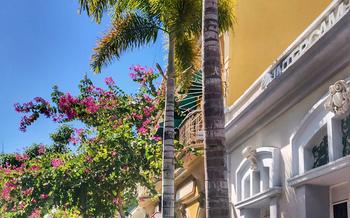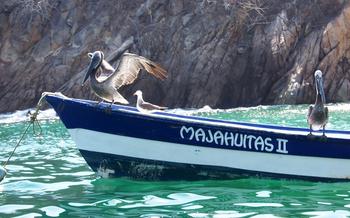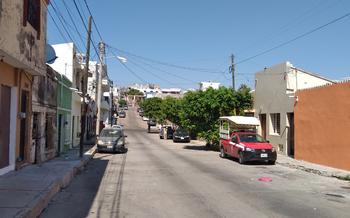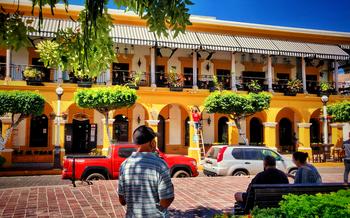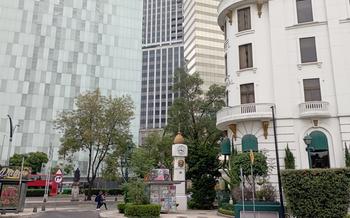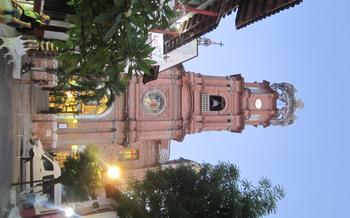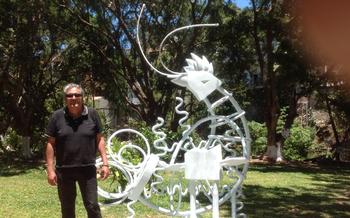
Copala
- Welcoming Mazatlán
- A Trip to Copala
- The Magic of the "Pueblo Magico"
- The Church of Our Lady of Assumption
- The Casa de Cultura
- The Museo de Arte
- The Jardin Botanico
- The Mercado Municipal
- The Plazuela Machado
- The Museo de la Mineria
- The Petroglyphs of Copala
- The Hot Springs of Copala
- The Copala River
- The Sierra Madre Occidental
- Insider Tip
Welcoming Mazatlán
**Mazatlán: A City city on Mexico's Pacific coast, has been a popular destination for centuries. Its rich history, diverse culture, and stunning natural beauty have made it a favorite among locals and tourists alike.
The city's origins date back to the 16th century when Spanish conquistadors established a settlement here. Over the years, Mazatlán has grown into a bustling port city and a major tourist destination. Today, visitors flock to Mazatlán to experience its beautiful beaches, colonial architecture, lively nightlife, and delicious cuisine.
Getting to Mazatlán is easy. The city is served by an international airport, and there are also several bus routes that connect it to other parts of Mexico. Once you arrive in Mazatlán, you'll have no shortage of options for places to stay. There are hotels and resorts to suit every budget, from budget-friendly hostels to luxurious beachfront properties.
When it comes to food, Mazatlán has something to offer everyone. The city is home to a wide variety of restaurants, serving everything from traditional Mexican fare to international cuisine. Be sure to try some of the local specialties, such as seafood, ceviche, and tamales.
A Trip to Copala
How to get to Copala
Copala is located about 60 miles northeast of Mazatlán. The drive takes about two hours. You can either rent a car or take a bus from Mazatlán to Copala. The bus ride costs about $10 and takes about three hours.
The history of Copala
Copala was founded in 1536 by Spanish conquistadors. The town was named after the Copala River, which flows nearby. Copala was once a major mining town, and it was home to many silver mines. However, the mines eventually closed, and the town's population declined. Today, Copala is a small town with a population of about 5,000 people.
The culture of Copala
Copala is a traditional Mexican town with a rich culture. The town is home to many colonial-era buildings, and the streets are lined with cobblestones. The people of Copala are friendly and welcoming, and they are always happy to share their culture with visitors.
What to see in Copala
Copala is a great place to visit for anyone who is interested in Mexican culture and history. The town is home to a number of interesting attractions, including the Church of Our Lady of Assumption, the Casa de Cultura, the Museo de Arte, the Jardin Botanico, and the Mercado Municipal. Copala is also a great place to go for hiking, biking, and horseback riding.
The Magic of the "Pueblo Magico"
Copala is a "Pueblo Magico", a designation given to towns in Mexico that have a special historical and cultural significance. The town is characterized by its cobblestone streets, colonial architecture, art galleries, and friendly locals.
The cobblestone streets of Copala are a reminder of the town's colonial past. The streets are narrow and winding, and they are often lined with brightly colored buildings. The colonial architecture of Copala is also well-preserved, and visitors can see many examples of Spanish colonial architecture in the town.
Copala is also home to a number of art galleries. The galleries feature the work of local artists, and visitors can find a variety of paintings, sculptures, and other works of art for sale. The friendly locals of Copala are always happy to welcome visitors to their town. They are proud of their town's history and culture, and they are always willing to share their stories with visitors.
The Church of Our Lady of Assumption
The Church of Our Lady of Assumption is one of the most important landmarks in Copala. It was built in the 18th century and is a beautiful example of colonial architecture. The church is made of stone and has a large bell tower. The interior of the church is decorated with intricate carvings and paintings. The church is a popular destination for pilgrims and tourists alike.
History: The Church of Our Lady of Assumption was built in the 18th century by the Jesuits. The church was built on the site of an older church that had been destroyed by fire. The church was completed in 1759 and was dedicated to Our Lady of Assumption.
Architecture: The Church of Our Lady of Assumption is a beautiful example of colonial architecture. The church is made of stone and has a large bell tower. The facade of the church is decorated with intricate carvings. The interior of the church is decorated with paintings and sculptures.
Interior: The interior of the Church of Our Lady of Assumption is spacious and well-lit. The church has a large nave and two aisles. The nave is lined with columns that support the vaulted ceiling. The aisles are lined with chapels. The church is decorated with paintings and sculptures.
Religious Significance: The Church of Our Lady of Assumption is a popular destination for pilgrims and tourists alike. The church is a symbol of the Catholic faith in Copala. The church is also a popular place for weddings and other celebrations.
The Casa de Cultura
The Casa de Cultura is a cultural center located in the heart of Copala. It was founded in 1987 by a group of local artists and has since become a hub for artistic and cultural activity in the town. The Casa de Cultura offers a variety of exhibits, classes, workshops, and cultural events throughout the year.
The Casa de Cultura is housed in a beautiful colonial building that was once a convent. The building has been restored and renovated to create a modern and inviting space for cultural expression. The Casa de Cultura has a large gallery space, a library, a theater, and several classrooms.
The exhibits at the Casa de Cultura showcase the work of local, national, and international artists. The exhibits are often thematic and explore a variety of topics, such as the history of Copala, the culture of Mexico, and the environment.
The Casa de Cultura offers a variety of classes and workshops for people of all ages. Classes are offered in a variety of disciplines, including painting, drawing, sculpture, photography, music, and dance. Workshops are often held on weekends and focus on specific topics, such as how to make a piñata or how to play a traditional Mexican instrument.
The Casa de Cultura also hosts a variety of cultural events throughout the year. These events include concerts, plays, film screenings, and lectures. The Casa de Cultura is a vital part of the cultural life of Copala and offers a variety of ways for people to experience and participate in the arts.
The Museo de Arte
The Museo de Arte de Sinaloa is a contemporary art museum located in the heart of Copala. The museum was founded in 1998 and is dedicated to promoting and preserving the visual arts of Sinaloa and Mexico. The museum's collection includes paintings, sculptures, drawings, prints, and photographs by both established and emerging artists.
The Museo de Arte is housed in a beautiful colonial-era building that was once a convent. The museum's galleries are spacious and well-lit, and the exhibits are thoughtfully curated. The museum also has a library, a research center, and an auditorium where lectures, workshops, and other events are held.
One of the highlights of the Museo de Arte is its collection of Mexican modern and contemporary art. The museum has works by some of the most important artists of the 20th and 21st centuries, including Diego Rivera, Frida Kahlo, David Alfaro Siqueiros, and Rufino Tamayo. The museum also has a strong collection of regional art, including works by artists from Sinaloa and neighboring states.
The Museo de Arte is a must-visit for anyone interested in Mexican art and culture. The museum's collection is impressive, and the exhibits are well-curated and informative. The museum is also a great place to learn about the history and culture of Sinaloa.
The Jardin Botanico
The Jardin Botanico de Copala is a beautiful and serene oasis located just outside of the town center. The garden was founded in 1972 by a group of local botanists and gardeners who were passionate about preserving the region's native plants. Today, the Jardin Botanico is home to over 1,000 species of plants, including many that are rare or endangered.
The garden is divided into several different sections, each of which focuses on a different type of plant. There is a section for cacti and succulents, a section for tropical plants, and a section for medicinal plants. There is also a section for children, which features a variety of interactive exhibits and activities.
The Jardin Botanico is a great place to learn about the native plants of the Sierra Madre Occidental. It is also a great place to relax and enjoy the beauty of nature. Visitors can stroll through the gardens, admiring the colorful flowers and lush foliage. They can also sit down on a bench and listen to the birds singing.
The Jardin Botanico is open to the public every day of the week, and admission is free. It is a great place to visit for anyone who is interested in plants, nature, or just relaxing in a beautiful setting.
The Mercado Municipal
The Mercado Municipal is a bustling marketplace in the heart of Copala. It is a great place to experience the local culture and find unique souvenirs. The market has been in operation for over 100 years, and it is a popular destination for both locals and tourists.
The market is divided into several sections, each specializing in different types of goods. There is a section for fresh produce, a section for meat and seafood, a section for clothing, and a section for souvenirs. You can find everything from handmade crafts to fresh tropical fruits at the Mercado Municipal.
The atmosphere at the market is lively and chaotic. Vendors hawk their wares, shoppers bargain for the best prices, and the air is filled with the sounds of people chatting and laughing. It is a great place to people-watch and get a feel for the local way of life.
If you are looking for a unique souvenir from Copala, be sure to visit the Mercado Municipal. You are sure to find something special to take home.
The Plazuela Machado
The Plazuela Machado is the heart of Copala. It is a charming square surrounded by colonial-era buildings, including the Church of Our Lady of Assumption, the Casa de Cultura, and the Museo de Arte. The square is a popular gathering place for locals and tourists alike, who come to enjoy the shade of the trees, the sound of the fountain, and the lively atmosphere.
The square was built in the 16th century and was originally used as a market. Over the years, it has been remodeled several times, but it has always retained its colonial charm. The square is paved with cobblestones and lined with trees, which provide shade from the sun. In the center of the square is a fountain, which is a popular spot for children to play.
The Plazuela Machado is a great place to people-watch and soak up the atmosphere of Copala. It is also a good place to start a walking tour of the town. From the square, you can easily reach all of the major sights, including the Church of Our Lady of Assumption, the Casa de Cultura, the Museo de Arte, and the Mercado Municipal.
The Museo de la Mineria
The Museo de la Mineria is a testament to the rich mining history of Copala. The museum is housed in a former mining hacienda that has been restored to its original splendor. The exhibits at the museum tell the story of the mining industry in Copala, from its early days to its present-day operations. Visitors can learn about the different methods of mining that have been used in Copala, as well as the tools and equipment that were used by the miners. The museum also has a collection of minerals and ores that were found in the mines of Copala.
The Museo de la Mineria is a must-visit for anyone who is interested in the history of Copala. The museum is open to the public from Tuesday to Sunday, and admission is free.
The Petroglyphs of Copala
The petroglyphs of Copala are a series of rock carvings that were created by the indigenous people of the region. The petroglyphs depict a variety of subjects, including animals, humans, and geometric designs. They are believed to have been created for a variety of reasons, including religious, ceremonial, and artistic purposes.
The petroglyphs are located in a number of different places around Copala, but the most popular site is located about a mile outside of town. The site is easily accessible by foot or by car, and there are a number of signs that will point you in the right direction.
Once you arrive at the site, you will be amazed by the number and variety of petroglyphs. The carvings are all very well-preserved, and they provide a fascinating glimpse into the lives of the people who created them.
The petroglyphs are a reminder of the rich history of Copala, and they are a valuable part of the town's cultural heritage. If you are visiting Copala, be sure to take some time to visit the petroglyphs. You won't be disappointed.
The Hot Springs of Copala
The hot springs of Copala are a popular tourist destination, and for good reason. The springs are located in a beautiful setting, surrounded by lush vegetation and towering mountains. The water is crystal clear and a comfortable temperature, making it ideal for swimming and soaking.
In addition to being relaxing, the hot springs are also said to have healing properties. The water is rich in minerals, which are believed to help with a variety of ailments, including arthritis, rheumatism, and skin problems.
There are several different ways to enjoy the hot springs. You can swim in the pools, soak in the private baths, or get a massage. There are also several restaurants and cafes located near the springs, so you can enjoy a meal or a snack while you're there.
The hot springs are located about 15 kilometers from Copala. To get there, you can take a taxi or a bus. The trip takes about 30 minutes.
The hot springs are open every day of the week. The hours vary depending on the season, so it's best to check before you go.
Admission to the hot springs is reasonable. You can expect to pay around $10 for a day pass.
Whether you're looking to relax, heal, or simply have some fun, the hot springs of Copala are a great place to visit.
The Copala River
The Copala River is a beautiful and refreshing natural wonder that flows through the heart of Copala. The river's source is in the Sierra Madre Occidental mountains, and it winds its way through the town before emptying into the Pacific Ocean. The Copala River is a popular spot for swimming, fishing, and boating.
The river is also home to a variety of wildlife, including fish, turtles, and birds. The banks of the river are lined with lush vegetation, making it a great place to go for a walk or a picnic.
If you are looking for a way to cool off and relax on your trip to Copala, the Copala River is the perfect place to go. You can swim, fish, boat, or simply relax on the banks and enjoy the scenery.
Insider Tip: The best time to visit the Copala River is during the dry season (November to April), when the water is clear and the weather is warm.
The Sierra Madre Occidental
The Sierra Madre Occidental is a vast mountain range that stretches along the western coast of Mexico. It is one of the longest mountain ranges in North America, and it is home to a wide variety of plant and animal life. The Sierra Madre Occidental is a popular destination for hiking, camping, and other outdoor activities.
Location: The Sierra Madre Occidental is located in the western part of Mexico. It stretches from the state of Sonora in the north to the state of Chiapas in the south. The range is about 1,500 miles long and 200 miles wide.
Climate: The climate of the Sierra Madre Occidental varies depending on the elevation. In the lower elevations, the climate is tropical, with warm temperatures and high humidity. In the higher elevations, the climate is temperate, with cooler temperatures and lower humidity.
Flora and Fauna: The Sierra Madre Occidental is home to a wide variety of plant and animal life. The range is home to over 3,000 species of plants, including many endemic species. The range is also home to a variety of animals, including jaguars, pumas, ocelots, and tapirs.
Recreational Activities: The Sierra Madre Occidental is a popular destination for hiking, camping, and other outdoor activities. The range offers a variety of trails for hikers of all levels. There are also a number of campgrounds located throughout the range. The Sierra Madre Occidental is also a popular destination for mountain biking, horseback riding, and fishing.
Insider Tip
The Best Time to Visit Copala
The best time to visit Copala is during the dry season, which runs from November to April. During this time, the weather is warm and sunny, with little chance of rain. However, it is important to note that Copala can be very hot and humid during the summer months, so it is important to dress accordingly.
Where to Find the Best Food in Copala
Copala is home to a variety of restaurants serving traditional Mexican cuisine. Some of the most popular dishes include pozole, enchiladas, and tacos. There are also a number of restaurants that serve international cuisine, such as Italian and Chinese.
How to Avoid the Crowds in Copala
Copala is a popular tourist destination, so it is important to be prepared for crowds, especially during the peak season. If you want to avoid the crowds, it is best to visit Copala during the shoulder season (May-June and September-October). You can also avoid the crowds by visiting Copala during the week, rather than on the weekends.
What to Pack for a Trip to Copala
When packing for a trip to Copala, it is important to bring lightweight, breathable clothing. You will also need to bring a hat, sunglasses, and sunscreen to protect yourself from the sun. If you are planning on doing any hiking, you will also need to bring comfortable shoes and a water bottle.
